The man, who was aged over 65, fell from height on a farm in Aberdeenshire on 10 January 2019.
Meanwhile, the HSE has also reported that a member of the public was killed on farm in a separate incident last year.
Again, the victim was a man aged over 65 and was killed after being trampled by cattle while walking his dog. The incident happened on a farm in East Sussex on 8 October 2018.
Falling from height and cattle-related incidents are both common causes of death and serious injury on farm, which can be avoided by making some small changes.
For instance, working on a roof requires the right training and equipment, so consider using a competent contractor if you do not possess these.
If you cannot use a contractor, and need to work on or near a fragile roof, try to use the following methods in order of preference:
- Work from underneath the roof using a suitable work platform, such as a tower scaffold, or where this is not possible;
- Use a mobile elevating work platform (MEWP) that allows people to work from the MEWP basket without standing on the roof itself, or where this is not possible;
- Before going on the roof, consult a specialist and use the right equipment. Normally this will mean using staging with handrails, scaffold edge protection, a good access ladder or tower and trained people. See the HSE roof work guidance.
More detailed guidance for working at height on farm can be found on the HSE website and in the HSE’s brief guide.
If you have cattle on your farm, taking the following actions would help lower the risk of cattle-related incidents:
- Cows with young calves should be kept in fields without public access.
- Members of the public are unlikely to understand cattle behaviour. Consider ways in which animals can be segregated from rights of way with physical means such as temporary fencing.
- Remove animals that show signs of aggression from the herd but don’t sell on a problem. Keep ‘flighty’ animals in fields with no public access.
- Check that paths are clearly marked and that fences are secure and well maintained. Site feed locations and troughs away from paths and stiles.
- Consider the nature of the cattle you put in fields with public access. Take account of the age of animals, the presence of calves and the influence of changing conditions, like weather and increased footfall at holiday times.
- You should judge animal behaviour when members of the public are present, especially if they are walking dogs or with children, moving animals when appropriate to alternative fields.
- Display signs when a bull is present.
Again, further guidance has been produced by the HSE, including an information sheet on grazing cattle on land with public access and livestock-specific pages on their website.
